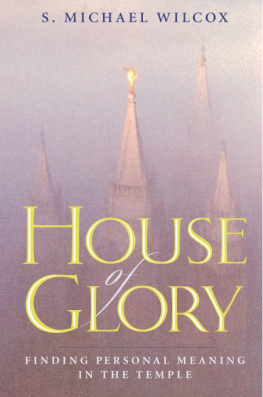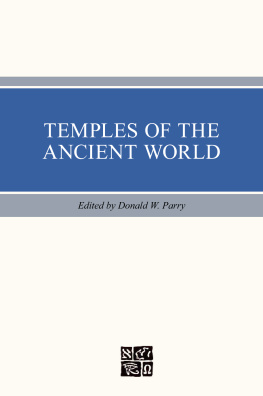Contents
Temple Symbols
Elder John A. Widtsoe served as an apostle from 1921 until his death in 1952. Deeply involved with temple and genealogy work, he wrote, No man or woman can come out of the temple endowed as he should be, unless he has seen, beyond the symbols, the mighty realities for which the symbols stand (Temple Worship, 62).
But why, many people wonder, must we use symbols? Why cant the temple ceremony just tell us plainly what we need to know? The problem is that some things cannot be explained in plainness. How, for example, could you tell someone how to ride a bicycle? The only way to learn is to do it, to have the actual experience. Many things in life are like that, including life itself.
The Prophet Joseph Smith said, Reading the experience of others, or the revelation given to them, can never give us a comprehensive view of our condition and true relation to God. Knowledge of these things can only be obtained by experience through the ordinances of God set forth for that purpose.
Elder Boyd K. Packer explained, If you will go to the temple and remember that the teaching is symbolic, you will never go in the proper spirit without coming away with your vision extended, feeling a little more exalted, with your knowledge increased as to things that are spiritual (The Holy Temple, 34).
There are several keys that can help us understand these sacred symbols.
Key 1: A symbol resembles the thing it stands for
One key to understanding a symbol is that it often resembles the thing it stands for. For example, the bread and water of the sacrament represent the body and blood of the Saviorin that order. It would make no sense to have bread represent the Saviors blood or to have water represent the Saviors body. Bread, like flesh, is solid; water, like blood, is liquid.
Another example is the decoration embroidered on the clothing of the high priest in the Old Testament: They made upon the hems of the [high priests] robe pomegranates of blue, and purple, and scarlet (Exodus 39:24). Have you ever eaten a pomegranate? If so, you know that it is full of seeds. So the pomegranate can be seen as a symbol of fertility, of posterity. In addition, the juice of the pomegranate is red, suggesting blood, or life: The life of all flesh is the blood thereof (Leviticus 17:14).
After Adam and Eve partook of the forbidden fruit, they knew that they were naked; and they sewed fig leaves together, and made themselves aprons (Genesis 3:7). What color are fig leaves? Green, which symbolizes life and growth. Figs also contain hundreds of tiny seeds, so the fig, like the pomegranate, can represent fertility and posterity. In addition, it was only after the Fall that Adam and Eve were able to have children. As Eve said, Were it not for our transgression we never should have had seed (Moses 5:911).
Key 2: Symbols can have more than one meaning
Just because a symbol represents one thing doesnt mean it cannot represent another as well. For example, the seed that Eve mentioned (her posterity) also has another meaning: The Lord God said unto the serpent,... I will put enmity between thee and the woman, and between thy seed and her seed; it shall bruise thy head, and thou shalt bruise his heel (Genesis 3:1415). The footnote in the Latter-day Saint edition of the Bible points out that the word translated here as it is really he in Hebrew: he shall bruise thy head. In addition, the footnotes explain, the Hebrew word translated as bruise can also mean crush, or grind: he shall crush thy head. Finally, in the original Hebrew, the word for seed is singular rather than plural; this verse refers to one specific seed, the Savior. Hebrews 2:14 explains, As the children are partakers of flesh and blood, [Jesus]... himself... took part of the same; that through death he might destroy him that had the power of death, that is, the devil.

This depiction of the Crucifixion, a stained-glass window from Chartres Cathedral, shows the Savior on a cross of green and red, the colors of life, prefiguring his and our resurrection. In the Middle Ages, the cross was thought to have been made of wood from the tree of life.
Again consider the sacrament. Yes, the bread and water represent the Saviors body and blood. But they also, in themselves, provide nourishment. Thus, they represent both death and life, showing that Jesus died so we might live. Baptism has these same two meanings. We go down into the water, which represents death, and we come up out of the water, which represents a new birth, both physical and spiritual: We are buried with [Christ] by baptism into death: that like as Christ was raised up from the dead by the glory of the Father, even so we also should walk in newness of life. For if we have been planted together in the likeness of his death, we shall be also in the likeness of his resurrection (Romans 6:35).
Key 3: Symbols can have suggested meanings as well as specific meanings
Symbols with specific meanings (such as the bread and water of the sacrament) can also suggest other meanings. In other words, they have connotations as well as denotations. For example, bread (as used in the sacrament) tastes good. That fact may bring to mind Almas sermon on planting the Lords word in our hearts: If ye do not cast it out by your unbelief, that ye will resist the Spirit of the Lord, behold, it will begin to swell within your breasts; and when you feel these swelling motions, ye will begin to say within yourselvesIt must needs be that this is a good seed, or that the word is good, for it beginneth to enlarge my soul; yea, it beginneth to enlighten my understanding, yea, it beginneth to be delicious to me (Alma 32:28).
The refreshing water used in the sacrament may make us think about the Saviors words to the woman at the well: Whosoever drinketh of the water that I shall give him shall never thirst; but the water that I shall give him shall be in him a well of water springing up into everlasting life (John 4:14).
Almas conclusion may apply to the sacrament as a whole: Ye shall feast upon this fruit even until ye are filled, that ye hunger not, neither shall ye thirst (Alma 32:42).
Key 4: We can understand symbols by comparing them with other symbols
Sometimes we can understand a symbol better by comparing it with another symbol. This is true in the scriptures as well as in the temple. For example, consider the differences in the sacrament prayers:
O God, the Eternal Father, we ask thee in the name of thy Son, Jesus Christ, to bless and sanctify this bread to the souls of all those who partake of it, that they may eat in remembrance of the body of thy Son, and witness unto thee, O God, the Eternal Father, that they are willing to take upon them the name of thy Son, and always remember him and keep his commandments which he has given them; that they may always have his Spirit to be with them. Amen. [D&C 20:77]
O God, the Eternal Father, we ask thee in the name of thy Son, Jesus Christ, to bless and sanctify this wine to the souls of all those who drink of it, that they may do it in remembrance of the blood of thy Son, which was shed for them; that they may witness unto thee, O God, the Eternal Father, that they do always remember him, that they may have his Spirit to be with them. Amen. [D&C 20:79]
When we take the bread, we witness to God that we are willing to do certain things. When we take the water, we witness to God that we do just one of those things. Why might that be?
Here is another example: In the book of Abraham, the Gods create the earth; then they create animals in the following way:












